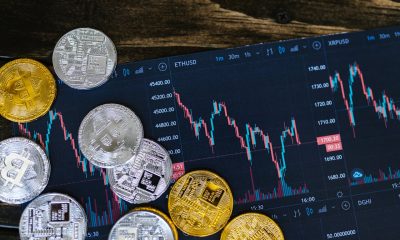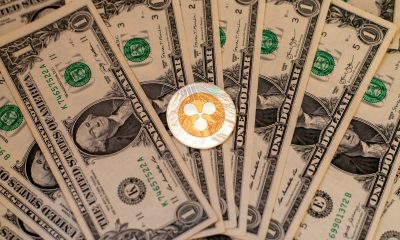Markets
The Monetary Juggling Act Continues, but the Clown’s Arms Are Getting Tired
Retail sales rose only 2.7% in July year-over-year, below the 2.9% inflation rate, indicating a real decline. Industrial production, manufacturing, and housing data also showed economic weakness. Despite asset bubbles supporting the wealthiest, overall consumer and economic strength is faltering. The Federal Reserve’s actions and market dynamics suggest impending challenges, with potential deflation and recession on the horizon.

Advanced retail sales accelerated by 1% for the month of July, according to figures that are seasonally adjusted but not adjusted for inflation. Economists surveyed by Dow Jones were looking for a 0.3% increase. June retail sales were revised to a decline of 0.2% after initially being reported as flat.
Retail sales in the spotlight
The Main Stream Financial Media went crazy over the July retail sales report–gleefully extolling the virtues of an American consumer that will do anything and everything to keep the economy afloat, even if it means burying themselves with even more debt. However, they didn’t emphasize that retail sales increased by a grand total of just 2.7% y/y in July.
And again, that number is reported in nominal terms, meaning the figure includes the effect of inflation. However, since the y/y CPI increased by 2.9%, according to the Bureau of Labor Statistics (BLS), the real figure for retail sales actually declined in the trailing 12-month period. In fact, according to David Stockman, inflation-adjusted retail sales have crashed by 7.1% since 2020.
That is the truth behind the strength of the consumer and the economy. The economy is not strong at all. Inflation has brutalized the bottom four quintiles of consumers, and the remaining top 20% is doing fine, thanks to the perpetuation of asset bubbles in stocks and home prices. But even the top quintile is in danger of having their financial condition torpedoed. More on that in a bit.
In other economic data, the New York Fed’s Empire State Manufacturing gauge edged higher but was still in negative territory at -4.7, slightly better than the -6 estimate. At the same time, the Philadelphia Fed manufacturing measure slid to -7, from +13.9. It’s first negative reading since January and well below the forecast for +7.9.
In addition, the Fed reported that industrial production slumped by -0.6% in July, worse than the forecast for -0.1%.
Turning to the all-important real estate sector, home builders’ confidence for August was 39, down from 50 a year ago. This is its lowest level since December 2023, and down for four months in a row. Building permits for July fell 4% m/m. Housing starts dropped by a substantial 6.8% m/m—that is the lowest level of new home construction since May 2020. By the way, investor purchases of single-family homes in Q2 of this year amounted to a whopping 69.4% of all such sales! I’m sure there’s nothing to see here; except a tsunami of shadow inventory waiting to hit the market once the recession hits.
The Conference Board Leading Economic Index for the U.S. fell by 0.6 percent in July 2024 to 100.4, following a decline of 0.2 percent in June. According to the report, In July, there was a sharp deterioration in new orders, persistently weak consumer expectations of business conditions, and softer building permits and hours worked in manufacturing drove the decline, together with the still-negative yield spread.
These data continue to suggest headwinds in economic growth going forward. The Conference Board expects U.S. real GDP growth to slow over the next few quarters as consumers and businesses continue cutting spending and investments. This indicator is now just below the recessions in the mid-70’s and early 80’s.
The labor market is slowing
The share of people who think they’re likely to be unemployed in the next four months reached a record high, according to the Federal Reserve Bank of New York Labor Market survey of consumer expectations that dates back to 2014. There were also a record number of individuals who were looking for a job.
Also, the Quarterly Census of Employment and Wages report came out this week and showed there were 818 thousand fewer jobs created in the period between March 2023 and March 2024 than initially reported by the BLS. This report is based on actual state unemployment tax records and covers 95% of all jobs. In other words, it is light years more accurate than the monthly Non-Farm Payroll report, which relies heavily on assumed job growth based on the Labor Department’s flawed birth/death model.
Hence, for those who want to believe the economy is rebounding and the stock market is giving the all-clear signal; buyer beware. At nearly 200% of GDP, the market value of equities has once again hit that nearly impenetrable wall of excess valuation.
The Fed has led the construction of asset bubbles that have reached massive proportions over the last two decades. We had positive real interest rates from 1980-2002; that is the natural situation. However, we have had negative real interest rates for 17 of the past 21 years. The Fed’s balance sheet, or (high-powered money) soared by $5 trillion, and M2 money supply has surged by over $6 trillion from 2020-2022.
This caused the leverage in the financial system to soar. For primary example, Global debt has skyrocketed to $307 T (340% GDP), which is up $100 trillion in the past decade.
But the truth is market liquidity has been evaporating.
- The fed’s balance sheet has shrunk from $9T in the middle of 2022 to just over $7T today.
- The Real FFR has been in positive territory for over a year after being negative for most of the time between 2002- 2023 and by as much as minus 8%. But now, the Fed’s dot plot is showing the overnight lending rate falling to only 4.1% by the end of 2025, which should still be well above the rate of inflation
- Banks’ lending standards have been tightened, and the inverted yield curve is crimping borrowing, thus, reducing the amount of new loans, i.e., now money created
- The Reverse Repo Facility has now just about become normalized, falling from $2.5T back in 2022 to just $300 billion today. This money represents banks’ excess reserves that were once parked at the Fed and outside of the economy; but has been pouring into T-bills for the past two years.
- And now, the yen carry traders have been put on thin ice
This means the liquidity fueling asset bubbles for the past few years has now been reduced to fumes. And it is these asset bubbles that have helped the wealthy prop up the economy. That support is being kicked out as the monetary gas tank is running on empty.
Wall Street is in full supplication mode for a series of Fed rate cuts to blow the stock market bubble into ever more lofty and rarified air. However, the proposed 100+ bps in rate cuts scheduled between September of this year and the end of ’25 have already been more than fully factored into mortgage rates and the valuation discount for S&P 500 earnings. The Effective Fed Funds Rate is now 5.3%, and the 10-year Note yield has crashed to just 3.9%. Therefore, once the Fed begins its rate-cutting cycle, it will just be following through on what the bond market has already priced in…and then some.
So, what Wall Street really needs is for the Fed to surprise investors with a series of aggressive rate cuts. But here is the catch: such a trenchant rate-cutting cycle would only be deployed in light of a deep economic contraction or the seizing up of credit markets. Therefore, in that context, achieving the 14% increase in S&P 500 EPS for 2025 would be impossible. Instead, EPS would be plunging.
The IDEC Model sits in sector 2 (disinflation and slowing GDP growth) for now. However, the probability of falling into sector 1 (deflation and recession) remains high. We remain on high alert for financial conditions and credit spreads to trigger the move to a more defensive allocation. Amazingly, the juggling act continues to press on, but the clown’s arms are getting tired.
__
(Featured image by TheDigitalArtist via Pixabay)
DISCLAIMER: This article was written by a third party contributor and does not reflect the opinion of Born2Invest, its management, staff or its associates. Please review our disclaimer for more information.
This article may include forward-looking statements. These forward-looking statements generally are identified by the words “believe,” “project,” “estimate,” “become,” “plan,” “will,” and similar expressions. These forward-looking statements involve known and unknown risks as well as uncertainties, including those discussed in the following cautionary statements and elsewhere in this article and on this site. Although the Company may believe that its expectations are based on reasonable assumptions, the actual results that the Company may achieve may differ materially from any forward-looking statements, which reflect the opinions of the management of the Company only as of the date hereof. Additionally, please make sure to read these important disclosures.

-

 Business2 weeks ago
Business2 weeks agoTopRanked.io Weekly Affiliate Digest: What’s Hot in Affiliate Marketing [+ HealthTrader Affiliates FAQ]
-

 Crypto2 days ago
Crypto2 days agoXRP Poised for a Breakout: Why 2026 Could Finally Deliver the Growth 2025 Delayed
-

 Crypto1 week ago
Crypto1 week agoRipple Expands in Singapore as XRP Slips and RLUSD Takes Center Stage
-

 Markets5 days ago
Markets5 days agoPrecious Metals Surge While Major Indexes Hold Strong Amid Holiday Lull
























